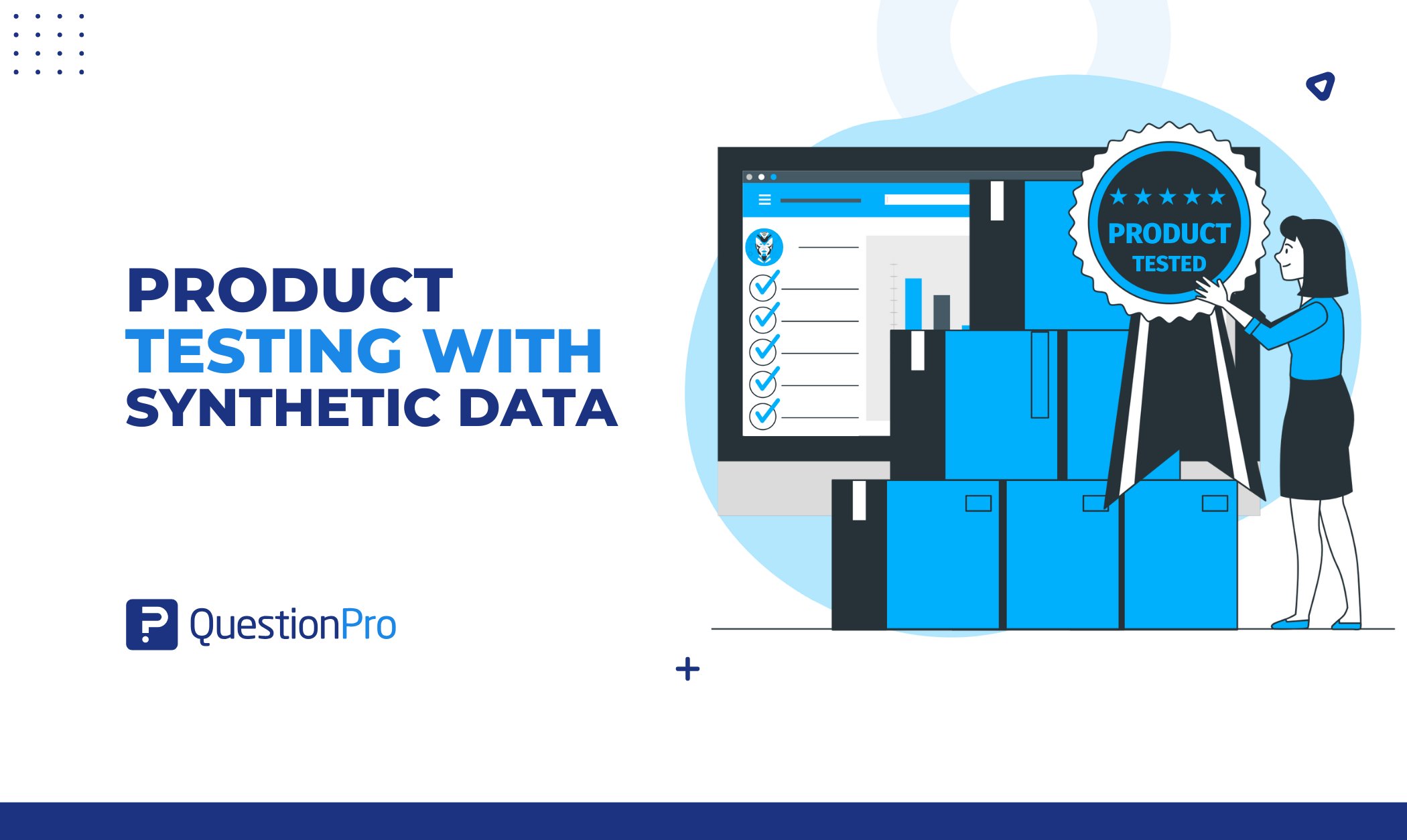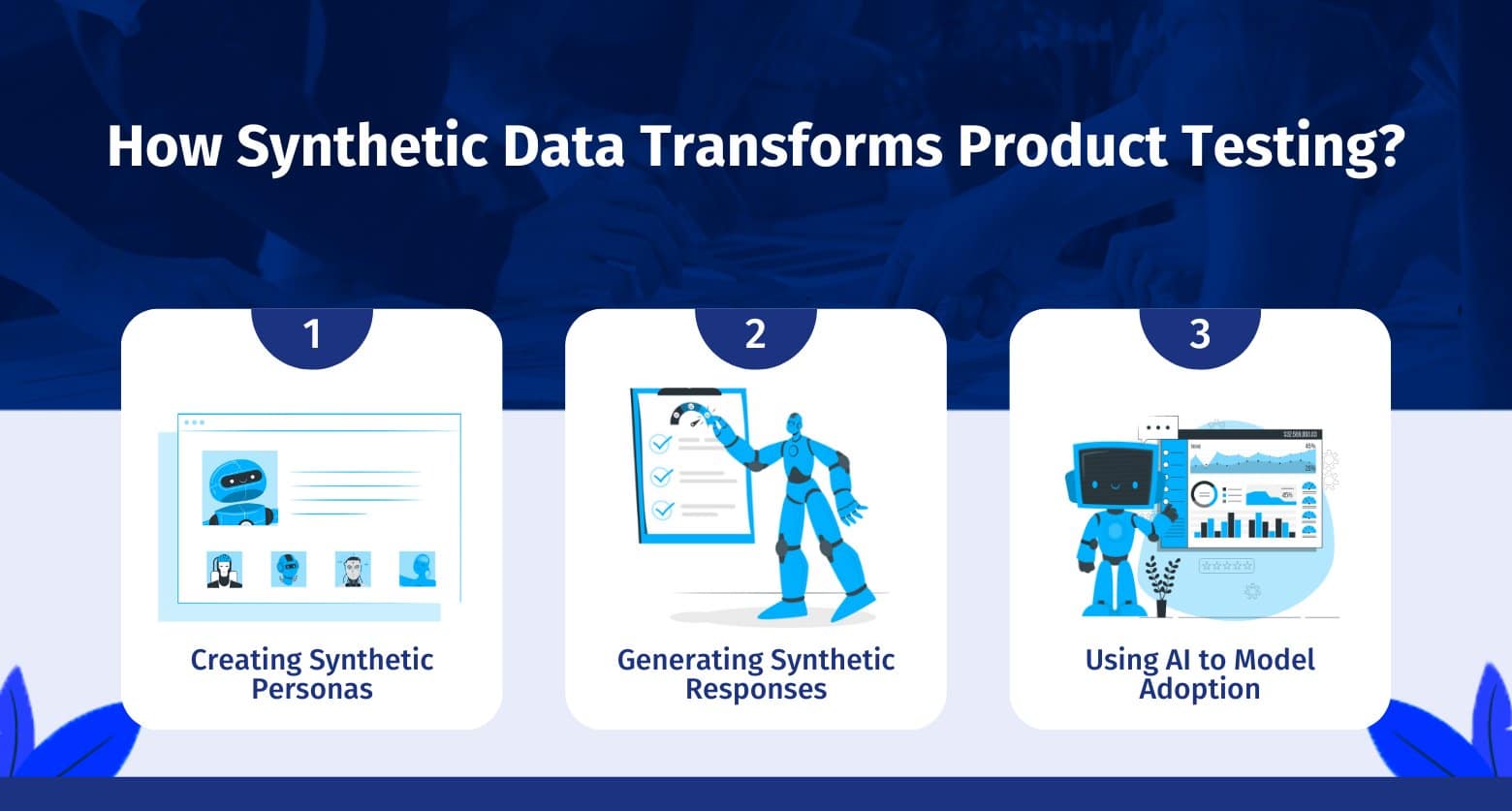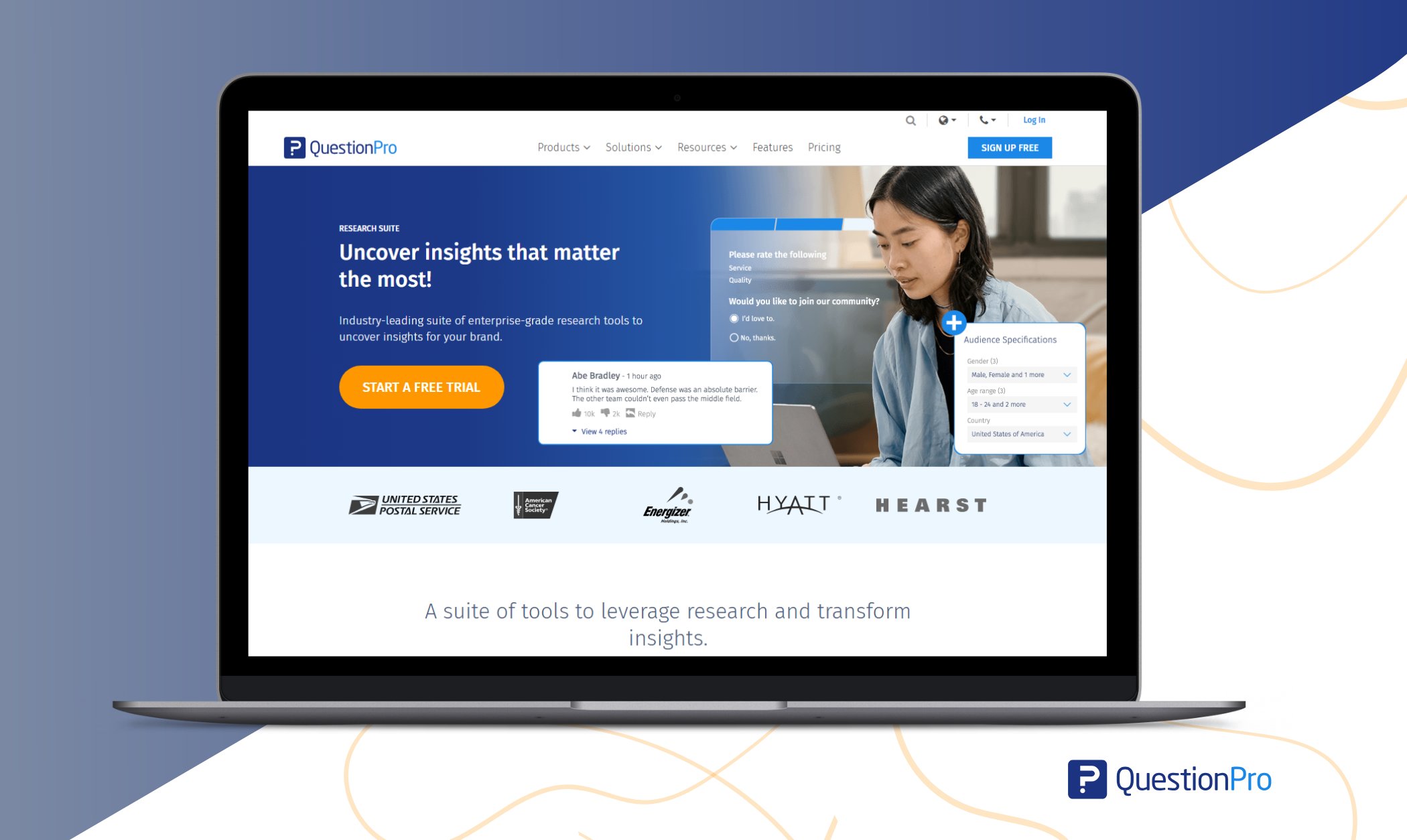
Launching a new product is risky. Will customers like it? How will they use it? What price will they pay? The answers come from months of surveys, focus groups, and live testing. But there’s a new option: product testing with synthetic data, an AI-driven method to simulate customer behavior before your product even hits the market.
By generating synthetic feedback, synthetic respondents, and simulated scenarios, you can test product features, pricing, and positioning in a virtual environment. In this blog, we’ll explore how product testing with synthetic data works, its role, why it matters, and applications to future-proof your product research.
At QuestionPro, we’re helping brands adopt synthetic data for agile product research. Whether you’re building a new app, developing consumer goods, or testing B2B services, synthetic data lets you predict outcomes, validate ideas, and refine your strategy all in record time.
What is Synthetic Data?
Synthetic data is artificially generated information designed to mimic the patterns and statistical properties of real-world data. Think of it as a privacy-safe “digital twin” of your actual datasets. This makes it a powerful tool for product testing with synthetic data, enabling rich validation without compromising user privacy or facing data scarcity.
Not all synthetic data is created the same way! Based on your needs, you can choose from three primary flavors:
- Fully Synthetic: Wholly fabricated data, built from scratch using statistical models.
- Partially Synthetic: Real production data with only high-risk fields (like IDs or financials) replaced by artificial values.
- Hybrid: An innovative blend of real and synthetic records, balancing privacy protection with practical utility.
Synthetic data is gaining traction in market research due to its ability to address privacy concerns, reduce costs, and provide readily available datasets for testing and model validation. It enables researchers to generate diverse, unbiased data on demand, which is especially useful in fields where real data is scarce or sensitive.
The Role of Synthetic Data in Product Testing
High-quality synthetic data is key to product testing, so you can simulate real-world scenarios without needing large user datasets. It helps product development, predicts user reactions, and optimizes features before launch, saving time and resources.
1. Simulating Customer Interactions with New Products
Realistic synthetic data simulates customer interactions, gives you insights into user behavior and preferences. Early feedback allows you to fix issues and improve the product before release.
2. Testing Different Product Configurations Virtually
Synthetic data allows virtual testing of different product configurations:
- Test designs without prototypes.
- Simulate user reactions.
- Find the best configurations.
This saves development time so you can focus on the best options.
3. Predicting User Behavior Before Market Launch
Predicting how users will behave before launch is crucial. Synthetic datasets let you create realistic user profiles so you can refine marketing and product features to reduce launch risk.
4. Optimizing Product Features for Diverse User Scenarios
Synthetic data also optimizes product features by simulating different user scenarios so the product works well in different environments and contexts.
- Simulate different user environments (like different devices).
- Address different user preferences and pain points.
- Fine-tune features for better accessibility and usability.
By reflecting different situations, you can fine-tune features for usability, accessibility, and customer satisfaction.
Including synthetic data in product testing lets you simulate real-world conditions so you can make better decisions and have successful products. It’s a cost-effective and efficient way to understand user behavior, test configurations, and optimize features before market release.
Why Use Synthetic Data for Product Testing?
Synthetic data is changing the way we test products, making it faster, cheaper, and more flexible. It helps businesses improve their products, understand customer reactions, and refine features before launching them to the real world.
- Faster Testing Without Live Fieldwork: With synthetic data, you can test products quickly, skipping the slow and expensive fieldwork process.
- No Need for Large Samples: You don’t need to spend a lot on gathering big data sets. Synthetic data is a more affordable way to test products.
- Test Before Going Big: Test your product in a safe, low-risk environment before spending on real-world rollouts. This helps spot issues early and avoid costly mistakes.
- Simulate Different User Behaviors: Synthetic data lets you test a wide variety of user behaviors and scenarios, so you can fine-tune your product for many different situations.
- Generate Large Amounts of Data: You can easily create large volumes of synthetic data to test your product on a bigger scale, helping you cover more ground.
Using synthetic data in product testing makes the process easier, faster, and more cost-effective, leading to smarter decisions and better products.
How Synthetic Data Transforms Product Testing?
Testing with synthetic data is a powerful way to simulate real-world customer interactions and get products out fast. By using artificial data, you can test different scenarios, predict customer behavior, and make informed decisions without the need for large-scale sampling or live fieldwork.

1. Creating Synthetic Personas and Use-Case Scenarios
You create synthetic personas based on data insights, simulating a range of customers. These personas are then put into different use-case scenarios to test how they would use a product, so you can refine your product for different audiences.
2. Generating Synthetic Responses to Simulate Customer Feedback
Synthetic responses mimic real customer feedback, giving you insight into user satisfaction and pain points. This helps you optimize before launch:
- Simulate reviews and ratings.
- Identify areas to improve.
- Predict market reception.
- Spot issues quickly.
- Adjust features before launch.
By using synthetic feedback, you can refine products and avoid costly mistakes when you go live.
3. Using AI to Model Adoption Curves, Preferences, and Churn
AI models let you predict how customers will use your product over time.
- Simulate product adoption based on synthetic test data.
- Predict user preferences and adjust features.
- Estimate churn rates and suggest retention strategies.
This data-driven approach helps you understand how customers will behave in the long term so you can optimize for future success.
Performance testing with synthetic data lets you test, learn, and improve faster, so you can make better decisions and have more successful product launches.
Applications of Synthetic Data in Product Research
Synthetic data is an essential tool in product research, allowing you to simulate real-world customer interactions and test various aspects of a product before launch. Here’s how:
1. A/B Testing Simulations
Simulate User Interactions:
- Synthetic data lets you simulate A/B tests by generating fake customer responses.
- You can test different versions of a product or website and see how users would interact and which one performs best.
Quick Insights:
- Test multiple variations without waiting for real-world feedback.
- Get insights on which one maximizes user engagement and satisfaction.
2. Pricing Strategy Optimization
You can use synthetic data to model different pricing strategies and see how customers would react to each.
For example, you can simulate the effect of offering a product at different price points and get feedback from synthetic personas to see which price maximizes revenue or customer retention. This way you can find the right price without risking real customer dissatisfaction.
3. Usability and Feature Prioritization Testing
- Test User Interactions: Synthetic data lets you simulate how users interact with different product features. This helps you prioritize which features are most important to users and guide the product development process.
- Refine Product Features: By testing with synthetic users, you can identify pain points and fine-tune your offerings before launch.
4. Forecasting Demand in New Markets
Synthetic data is useful for predicting how a product will perform in new, untapped markets. It helps you predict how a product will perform in new markets by:
- Simulating local preferences.
- Considering cultural differences.
- Analyzing market trends.
This way, you can make data-driven decisions on entering new markets.
By incorporating synthetic data into product research, you can experiment, optimize, and predict outcomes efficiently, resulting in better decisions and successful product launches.
How QuestionPro Helps Product Testing with Synthetic Data
QuestionPro Research Suite offers several advanced tools to help businesses integrate synthetic data into their product testing processes, ensuring products are optimized and aligned with customer preferences before launch. Here’s how it works:

1. AI-Powered Simulations for Product-Market Fit Studies
QuestionPro’s AI-powered simulations help businesses assess product-market fit by generating synthetic data that mimics real customer interactions. This enables companies to:
- Test features and configurations across market segments.
- Ensure the product meets customer needs before launch.
2. Integrating Synthetic Respondents into Product Research Workflows
QuestionPro allows businesses to integrate synthetic respondents into their research workflows. This helps test product features, pricing, and messaging efficiently, simulating customer feedback without large-scale sampling and speeding up the process.
3. Using Conjoint Analysis and MaxDiff with Synthetic Inputs
Synthetic data in QuestionPro supports conjoint analysis and MaxDiff, providing insights into customer preferences for different product features. Companies can simulate feedback from various personas to understand which features matter most.
4. Simulating Product Adoption in New Markets
QuestionPro helps businesses simulate product adoption in new markets by generating synthetic data based on:
- Local preferences.
- Cultural differences.
This approach allows companies to forecast demand and market reception, reducing the risks of expanding into unfamiliar regions.
5. Enhancing Feature Prioritization with Synthetic Data
Using synthetic data, QuestionPro allows businesses to test and prioritize product features based on simulated customer feedback. This helps companies refine features that resonate most with their target audience, ensuring a more successful product launch.
QuestionPro’s tools help businesses quickly and efficiently test products using synthetic data, optimizing for market success and customer satisfaction.
Conclusion
Synthetic data isn’t just a theory; it’s the new way to innovate responsibly. Throughout this post, we’ve seen how testing with synthetic data breaks down barriers, including data scarcity, privacy, and scenarios that were previously impossible to test.
Tools like QuestionPro can help you use synthetic data for product testing. By intelligently blending synthetic and real data, businesses gain speed and efficiency, transforming testing from a bottleneck into a strategic advantage.
The future is for the bold but responsible. Synthetic data isn’t about replacing reality; it’s about mastering it safely. Join the shift and turn testing limitations into your most significant advantage.
Frequently Asked Questions (FAQs)
Answer: Synthetic data can simulate how customers will interact with a product, providing early feedback on user behavior and preferences, which helps identify and fix issues before release.
Answer: AI powers simulations that generate synthetic data, helping businesses test features, predict customer behavior, and model adoption curves, preferences, and churn rates to optimize products before launch.
Answer: Synthetic data allows businesses to simulate various user scenarios, refine product features based on customer feedback, and ensure that products meet diverse user needs and preferences before launch.
Answer: QuestionPro offers AI-powered simulations, integrates synthetic respondents into research workflows, supports conjoint analysis and MaxDiff, and helps simulate product adoption in new markets to optimize product testing.
Answer: Synthetic data is gaining popularity due to its ability to address privacy concerns, reduce testing costs, generate diverse data on demand, and simulate scenarios that are difficult or impossible to test with real data.







